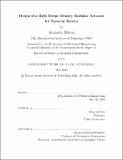| dc.contributor.advisor | Sangbae Kim. | en_US |
| dc.contributor.author | Hattori, Alexander. | en_US |
| dc.contributor.other | Massachusetts Institute of Technology. Department of Mechanical Engineering. | en_US |
| dc.date.accessioned | 2020-09-03T17:50:17Z | |
| dc.date.available | 2020-09-03T17:50:17Z | |
| dc.date.copyright | 2020 | en_US |
| dc.date.issued | 2020 | en_US |
| dc.identifier.uri | https://hdl.handle.net/1721.1/127165 | |
| dc.description | Thesis: S.M., Massachusetts Institute of Technology, Department of Mechanical Engineering, May, 2020 | en_US |
| dc.description | Page 74 blank. Cataloged from the official PDF of thesis. | en_US |
| dc.description | Includes bibliographical references (page 73). | en_US |
| dc.description.abstract | When designing new control systems for dynamic robots, differences between simulated and real-world physics can cause the robot hardware to experience a significant amount of misuse, often leading to downtime as hardware is continuously repaired and improved. The MIT Biomimetic Robotics Lab aimed to mitigate this problem by building the MIT Mini Cheetah, a low cost, mechanically robust, quadruped that was capable of tolerating the strains of testing new legged robot controls. One of the key design features of the Mini Cheetah that allows it to have minimized repair time compared to other dynamic robots is its use of the same modular actuators at all joints, allowing for easy replacement of components and a simpler mechanical design. These modular actuators consist of a hobby brushless motor with an internal planetary gearbox, a motor controller and a position sensor. This thesis documents the design and manufacturing of the new generation of Mini Cheetah-sized actuators. The new design utilizes a custom rotor design and a new module topology which allow for higher torque density in roughly the same form factor. The new module also incorporates a new, higher resolution encoder allowing for higher torque bandwidth. These new modules will be used in various research projects in the lab including a set of bilaterally teleoperated arms, a humanoid, and a new quadruped. | en_US |
| dc.description.statementofresponsibility | by Alexander Hattori. | en_US |
| dc.format.extent | 74 pages | en_US |
| dc.language.iso | eng | en_US |
| dc.publisher | Massachusetts Institute of Technology | en_US |
| dc.rights | MIT theses may be protected by copyright. Please reuse MIT thesis content according to the MIT Libraries Permissions Policy, which is available through the URL provided. | en_US |
| dc.rights.uri | http://dspace.mit.edu/handle/1721.1/7582 | en_US |
| dc.subject | Mechanical Engineering. | en_US |
| dc.title | Design of a high torque density modular actuator for dynamic robots | en_US |
| dc.type | Thesis | en_US |
| dc.description.degree | S.M. | en_US |
| dc.contributor.department | Massachusetts Institute of Technology. Department of Mechanical Engineering | en_US |
| dc.identifier.oclc | 1191847884 | en_US |
| dc.description.collection | S.M. Massachusetts Institute of Technology, Department of Mechanical Engineering | en_US |
| dspace.imported | 2020-09-03T17:50:17Z | en_US |
| mit.thesis.degree | Master | en_US |
| mit.thesis.department | MechE | en_US |
